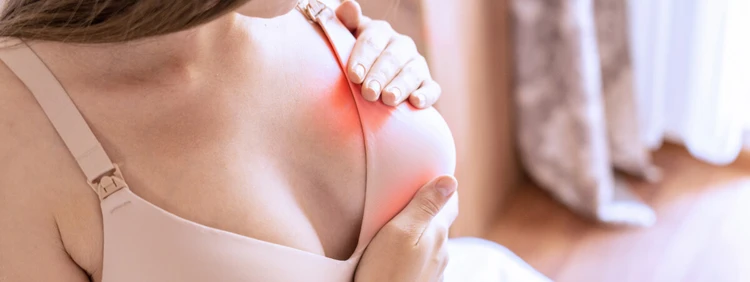Ever heard of Candida?
Specifically Candida albicans?
It’s a type of yeast or fungus that lives naturally in and on your body.
It usually just hangs out in warm, dark, moist areas like your vagina, mouth, gut, and on your skin without causing much trouble.
Candida albicans even does a few important jobs, like helping to get rid of unnecessary dead cells, and regulating your reproductive, digestive, and immune systems. [1]
Up to 70% of healthy people have Candida, with the body’s natural mix of healthy bacteria (microbiome) keeping candida growth under control. [2]
But too much yeast can cause some problems (ask any baker!). And if the Candida in your body gets out of control, it can cause an infection. When this happens, it’s called thrush.
On your skin, you’re likely to find thrush where the skin folds or where two skin areas touch each other.
This makes the warm, dark space underneath your breasts kind of ideal.
📝 In this article:
- What does a yeast infection under breasts look like?
- What causes a fungal rash on breasts?
- How can you treat a fungal infection under your breasts?
What does a yeast infection under breasts look like?
A yeast infection underneath or on your breasts or nipples looks like a raised, shiny, red, or reddish-brown rash. It’s often itchy or painful. [3]
If it gets quite serious, it can make your skin crack, and might even cause crusting, oozing blisters, and bleeding.
Are you breastfeeding? A stabbing or shooting pain when you express milk or feed, or bright pink nipples, might also be signs that you have thrush.

What causes a fungal rash on breasts?
Skin infections are common in mamas who are breastfeeding, and can normally be treated very easily (more on that below). [4]
You might find that you get thrush soon after you start breastfeeding your brand-new baby.
This usually happens if your baby has thrush in their mouth (which might happen if you had vaginal thrush when you gave birth or if your baby has taken antibiotics).
The whole thing is pretty unfair, we know.
Keep an eye out for thrush in your baby’s mouth or on their bottom.
In the mouth, it looks like white spots on the inside of their cheeks, a white coating on their tongue, or both.
On their bottom, it looks like a bright red rash. [5]
Speak to your doctor about the best course of action.
In mild cases no treatment might be given however, in more severe cases antifungal treatments might be given to your peanut.
Just always make sure you speak to your healthcare provider and never administered over-the-counter anti-fungals.
Sometimes mamas who are pregnant or breastfeeding get thrush from their clothing, too.
Ordinary bras, nursing bras, and clothing that doesn’t fit well or is too tight can trap sweat or cause friction that yeast just loves.
Yeast infections also tend to happen to people who are diabetic, obese, have very large breasts, live in hot climates, or take certain medications, like antibiotics or corticosteroids. [6]
How can you treat a fungal infection under your breasts?
There’s good news.
Yeast infections are usually quite easy to treat, and most go away within a week if you use an antifungal cream (this makes sense, since Candida is technically a fungus).
You could also choose an ointment or a tablet.
If your infection is quite bad, your doctor might prescribe medication for you, including one of several ‘zole’-ending drugs like Clotrimazole, Econazole, Ketoconazole, Miconazole, or Tioconazole. [7]
Anti-fungal creams that have steroids in them will help to make very itchy rashes feel better.
But (as the old saying goes!) prevention is better than cure.
Rather try to avoid yeast infections by keeping the skin under your breasts and nipples clean and dry. We know that this can be tricky if you’re breastfeeding, mama.
Our best advice is to try using disposable breast pads and changing them regularly so that they don’t stay wet against your skin for too long.
It’s also best not to sleep with your bra on, and to choose bras made of natural materials, like cotton, if you can.
While thrush usually clears for long periods of time, it can come back, especially if you’re breastfeeding.
If you get a yeast infection under your breasts again within two months, rather chat to your doctor.
They might be able to recommend some better, long-lasting remedies for you.
Looking for more breastfeeding advice?
20 Breastfeeding Tips for New Mamas
7 Breastfeeding Positions to Try
How to Stop Breastfeeding (When You’re Ready)
Breastfeeding in Public: Tips & Advice
Tips for Breastfeeding with Large Breasts

